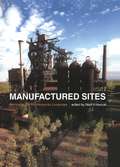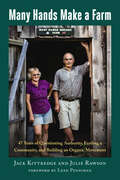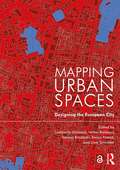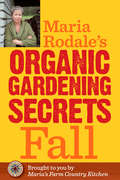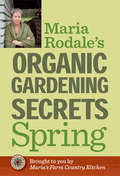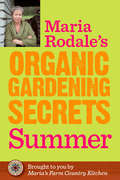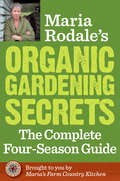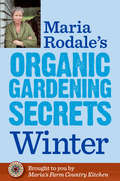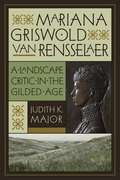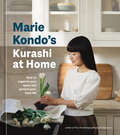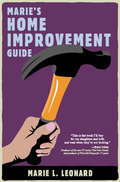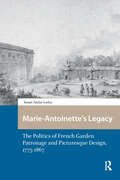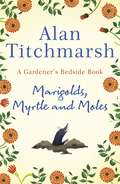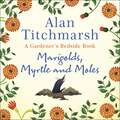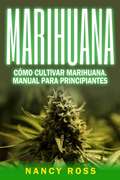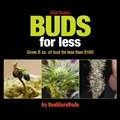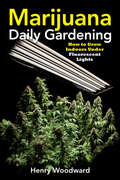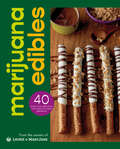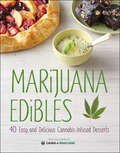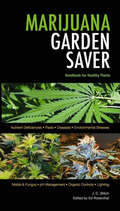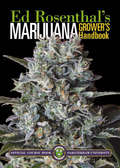- Table View
- List View
Manufactured Sites: Rethinking the Post-Industrial Landscape
by Niall Kirkwood**This title was originally published in 2001. The version published in 2011 is a PB reprint of the original HB** Manufactured Sites focuses on the legacy of industrial production and pollutants on the contemporary landscape and their influence on new scientific research, innovative site technologies and progressive site design. It presents innovative environmental, engineering and design approaches along with ongoing research and built projects of international significance. Contributions range from innovative scientific engineering research from industry and federal agencies to contemporary international and regional professional reclamation and redevelopment projects such as the 2000 Olympic Games in Sydney, Australia and the A.G. Thyssen steelworks and blast furnace planning in Germany's Ruhr region.
Many Hands Make a Farm: 47 Years of Questioning Authority, Feeding a Community, and Building an Organic Movement
by Jack Kittredge Julie RawsonFrom Northeast Organic Farmers Lifetime Achievement Award: Jack Kittredge and Julie RawsonIn this heartfelt and unflinching memoir, two activists recount the nearly half century they&’ve spent questioning authority while raising a family, building a self-reliant community, starting an organic farm, leading a farming organization, and experiencing the struggles and joys of living a purposeful life.Many Hands Make a Farm traces the journey of organic farming pioneers Julie Rawson and Jack Kittredge from their early years of bright-eyed excitement, through the long slog for economic stability, to the formation of a thriving community and a growing natural farming movement. Along the way, they established relationships with farming leaders across the country during the creation of the National Organic Program.Julie and Jack met while working as community organizers in Boston. After falling in love and starting a family, they decided to use Jack&’s irregular earnings as a board game designer to support a move to a rural area where they could grow healthy food and earn their living at home, so they could be present for their four children. What began as a family homestead soon grew into the small, diversified Many Hands Organic Farm.Julie and Jack have intentionally chosen to live their lives differently than the mainstream, prioritizing minimizing energy use, raising food organically, not relying on credit, favoring natural health care, participating in the arts, working creatively, and instilling the values of hard work and responsibility in their children.In a time when society at large was &“going along to get along,&” Julie and Jack stood out as leaders and iconoclasts. They believe that taking risks and making bold decisions can unlock one&’s potential and lead to actions that enrich the spirit, the family, and the community.Many Hands Make a Farm will resonate with fans of original thinkers from Henry David Thoreau and Wendell Berry to Lynn Margulis and Adelle Davis. The book strongly conveys the message of finding roots in a community, respecting the Earth, and combining social justice work with the joys and challenges of raising a family. These themes shine through on every page, making this memoir a must-read for anyone seeking inspiration and guidance on finding meaning in their life."Told in complementary, alternating narratives between husband and wife, this informative and heartfelt memoir is uplifting from start to finish."—Booklist
Mapping Urban Spaces: Designing the European City
by Uwe Schröder Lamberto Amistadi Valter Balducci Tomasz Bradecki Enrico PrandiMapping Urban Spaces focuses on medium-sized European cities and more specifically on their open spaces from psychological, sociological, and aesthetic points of view. The chapters illustrate how the characteristics that make life in medium-sized European cities pleasant and sustainable – accessibility, ease of travel, urban sustainability, social inclusiveness – can be traced back to the nature of that space. The chapters develop from a phenomenological study of space to contributions on places and landscapes in the city. Centralities and their meaning are studied, as well as the social space and its complexity. The contributions focus on history and theory as well as concrete research and mapping approaches and the resulting design applications. The case studies come from countries around Europe including Poland, Italy, Greece, Germany, and France, among others. The book will be of interest to students, scholars, and practitioners in architecture, urban planning, and landscape architecture.
Maria Rodale's Organic Gardening Secrets: Fall
by Maria RodaleMaria Rodale shares her top organic gardening secrets season-by-season in a guide that offers straight-forward, easy-to-follow gardening basics so that youcan enjoy a beautiful, bountiful, organic garden all year long!Fall explains learn how to extend your growing season into winter; pick out bulbs, trees, and shrubs; add color to your garden, and preserve your garden's bounty for winter. Maria also shares her very own recipes for a Thanksgiving feast.
Maria Rodale's Organic Gardening Secrets: Spring
by Maria RodaleMaria Rodale shares her top organic gardening secrets season-by-season in a guide that offers straight-forward, easy-to-follow gardening basics so that youcan enjoy a beautiful, bountiful, organic garden all year long!Spring explainshow to prepare for, plan, and plant your garden, as well as how to start your own seeds, improve soil health, create the best compost, build a raised bed, and harvest early crops.
Maria Rodale's Organic Gardening Secrets: Summer
by Maria RodaleMaria Rodale shares her top organic gardening secrets season-by-season in a guide that offers straight-forward, easy-to-follow gardening basics so that youcan enjoy a beautiful, bountiful, organic garden all year long!In Summer, you will find the best chemical-free bug solutions, easy organic weeding strategies, sustainable watering techniques, and simple, effective ways to boost your yield organically.
Maria Rodale's Organic Gardening Secrets: The Complete Four Season Guide
by Maria RodaleMaria Rodale shares her organic gardening secrets in a season-by-season guide that offers straight-forward, easy-to-follow gardening basics so that anyone can enjoy a beautiful, productive, organic garden all year long. In the spring, learn how to prepare for and plan your garden in order to ensure a bountiful 4-season garden, as well as how to improve your soil health, create the best compost, and harvest early crops. In the summer, find the best chemical-free bug solutions, easy organic weeding strategies, sustainable watering techniques, and simple effective ways to boost your yield organically. In the fall, learn how to extend your growing season into winter; pick out bulbs, trees, and shrubs; add color to your garden, and preserve your garden's bounty for winter. Maria also shares her very own recipes for a Thanksgiving feast. And in winter, learn how to plan for next year's garden, order the best seeds for your needs, and start seedlings indoors. Plus, Maria shares her favorite winter comfort food recipes.
Maria Rodale's Organic Gardening Secrets: Winter
by Maria RodaleMaria Rodale shares her top organic gardening secrets season-by-season in a guide that offers straight-forward, easy-to-follow gardening basics so that youcan enjoy a beautiful, bountiful, organic garden all year long!Winter explains how to prepare for and plan next year's garden, order the best seeds for your needs, and start seedlings indoors. Plus, Maria shares her favorite winter comfort food recipes!
Mariana Griswold Van Rensselaer
by Judith K. MajorMariana Griswold Van Rensselaer (1851-1934) was one of the premier figures in landscape writing and design at the turn of the twentieth century, a moment when the amateur pursuit of gardening and the increasingly professionalized landscape design field were beginning to diverge. This intellectual biography--the first in-depth study of the versatile critic and author--reveals Van Rensselaer's vital role in this moment in the history of landscape architecture. Van Rensselaer was one of the new breed of American art and architecture critics, closely examining the nature of her profession and bringing a disciplined scholarship to the craft. She considered herself a professional, leading the effort among women in the Gilded Age to claim the titles of artist, architect, critic, historian, and journalist. Thanks to the resources of her wealthy mercantile family, she had been given a sophisticated European education almost unheard of for a woman of her time. Her close relationship with Frederick Law Olmsted influenced her ideas on landscape gardening, and her interest in botany and geology shaped the ideas upon which her philosophy and art criticism were based. She also studied the works of Charles Darwin, Alexander von Humboldt, Henry David Thoreau, and many other nineteenth-century scientists and nature writers, which influenced her general belief in the relationship between science and the imagination.Her cosmopolitan education and elevated social status gave her, much like her contemporary Edith Wharton, access to the homes and gardens of the upper classes. This allowed her to mingle with authors, artists, and affluent patrons of the arts and enabled her to write with familiarity about architecture and landscape design. Identifying over 330 previously unattributed editorials and unsigned articles authored by Van Rensselaer in the influential journal Garden and Forest--for which she was the sole female editorial voice--Judith Major offers insight into her ideas about the importance of botanical nomenclature, the similarities between landscape gardening and idealist painting, design in nature, and many other significant topics. Major's critical examination of Van Rensselaer's life and writings--which also includes selections from her correspondence--details not only her influential role in the creation of landscape architecture as a discipline but also her contribution to a broader public understanding of the arts in America.
Marie Kondo's Kurashi at Home: How to Organize Your Space and Achieve Your Ideal Life (The Life Changing Magic of Tidying Up)
by Marie KondoTransform your home into a haven of calm and achieve your ideal lifestyle with this inspirational visual guide featuring more than 100 photographs, from the Netflix star and #1 bestselling author of The Life-Changing Magic of Tidying Up. Inspired by the Japanese concept of kurashi, or &“way of life,&” Kurashi at Home invites you to visualize your best life from the moment you wake up until the end of each day. By applying Marie Kondo's time-tested query—&“Does it spark joy?&”—to your mindset and behaviors, you are invited to take an even more holistic and personal approach to curating your environment by imagining what your life could look like full of connection and free from any limitations. This ideal vision then becomes a touchpoint that helps you make conscious, mindful choices—from how you use every corner of your living space to how you take advantage of every moment. At its core, the KonMari philosophy focuses not on what to get rid of, but on what sparks joy in your life. In this inspirational visual guide, beautiful photographs and Kondo's unique suggestions empower you to embrace what you love about your life and then reflect it in your home, activities, and relationships, like creating a calm nook for working, scheduling weekly get-togethers with family or friends, or having relaxing nighttime rituals that promote a restful sleep. Your newfound clarity will inspire you to clear out the unneeded clutter so you can appreciate the inviting spaces, treasured belongings, and peaceful moments that remain.
Marie's Home Improvement Guide
by Marie L. LeonardTired of paying the painter to create a mess on your floors? Can't be held up another day waiting for a plumber between 9 and 5? Feeling threatened by the growing pile of fix-it projects in your basement? Marie's Home Improvement Guide offers all the tips you need to tackle these projects ... yourself! Marie L. Leonard, owner of her own home improvement business, has been teaching home repair to women for years. With the belief that women shouldn't have to depend on others for home repair, Leonard is helping thousands of women save money and time, conquering the fear of do-it-yourself work. Marie's Home Improvement Guide provides readers with the know-how to tackle projects around the house. Leonard covers the basics: introduction to tools, safety precautions, necessary prep-work, and shopping for the right materials. Leonard's tips are written in an informative and accessible manner, paired with detailed illustrations. A reassuring source of encouragement, Marie's Home Improvement Guide is a must-have book for all first-time do-it-yourselfers.
Marie-Antoinette’s Legacy: The Politics of French Garden Patronage and Picturesque Design, 1775-1867 (Spatial Imageries in Historical Perspective)
by Susan Taylor-LeducChallenging the established historiography that frames the French picturesque garden movement as an international style, this book contends that the French picturesque gardens from 1775 until 1867 functioned as liminal zones at the epicenter of court patronage systems. Four French consorts—queen Marie-Antoinette and empresses Joséphine Bonaparte, Marie-Louise and Eugénie—constructed their gardens betwixt and between court ritual and personal agency, where they transgressed sociopolitical boundaries in order to perform gender and identity politics. Each patron endorsed embodied strolling, promoting an awareness of the sentient body in artfully contrived sensoria at the Petit Trianon and Malmaison, transforming these places into spaces of shared affectivity. The gardens became living legacies, where female agency, excluded from the garden history canon, created a forum for spatial politics. Beyond the garden gates, the spatial experience of the picturesque influenced the development of cultural fields dedicated to performances of subjectivity, including landscape design, cultural geography and the origination of landscape aesthetics in France.
Marigolds, Myrtle and Moles: A Gardener's Bedside Book - the perfect book for gardening self-isolators
by Alan Titchmarsh'Charming miscellany of rhymes and reflections celebrating the garden'CHOICE***The perfect bedside book for the green-fingered - hilarious and touching poems on a gardening theme written and introduced by the nation's favourite gardener and presenter of ITV's Grow Your Own At Home and Love Your Garden, Channel 5's Secrets of the National Trust and with his own show on Classic FM.From touching poems on the peony, the snowdrop and the sweet pea to hilarious verse on Emily the Gardener and the Garden Design Course, this is Alan Titchmarsh's heartfelt and entertaining celebration of his favourite space - the garden.
Marigolds, Myrtle and Moles: A Gardener's Bedside Book - the perfect book for gardening self-isolators
by Alan Titchmarsh'Charming miscellany of rhymes and reflections celebrating the garden'CHOICE***The perfect bedside book for the green-fingered - hilarious and touching poems on a gardening theme written and introduced by the nation's favourite gardener and presenter of ITV's Grow Your Own At Home and Love Your Garden, Channel 5's Secrets of the National Trust and with his own show on Classic FM.From touching poems on the peony, the snowdrop and the sweet pea to hilarious verse on Emily the Gardener and the Garden Design Course, this is Alan Titchmarsh's heartfelt and entertaining celebration of his favourite space - the garden.
Marigolds, Myrtle and Moles: A Gardener's Bedside Book - the perfect book for gardening self-isolators
by Alan TitchmarshThe perfect listen for the green-fingered - hilarious and touching poems on a gardening theme written and introduced by the nation's favourite gardener and presenter of ITV's Love Your Garden, Channel 5's Secrets of the National Trust and with his own show on Classic FM.From touching poems on the peony, the snowdrop and the sweet pea to hilarious verse on Emily the Gardener and the Garden Design Course, this is Alan Titchmarsh's heartfelt and entertaining celebration of his favourite space - the garden.(P) 2020 Hodder & Stoughton Ltd
Marihuana: Cómo cultivar marihuana. Manual para principiantes
by Nancy Ross Yussef Chaib Abderrahman Elena Pérez Galiano¡APRENDE CÓMO CULTIVAR MARIHUANA TÚ MISMO! Un anticipo de lo que aprenderás: Beneficios de cultuvar tu propio cannabis Cultivo interior vs. cultivo exterior Normas básicas para cultivar cannabis Cómo lidiar con plagas y otros inconvenientes Tipos de sistemas hidropónicos Cosechar ¡Y mucho, mucho más!
Marijuana 101
by Professor LeeUnlike the vast majority of other grow books, Marijuana 101 reads like an informal study guide for an "Introduction to Growing" course run by a professor who had a successful grow for a decade. Professor Lee involves his readers and helps them over each potential stumbling block, with constant reference to his own experience, giving the book the personal touch similar guides lack. Lee discusses what to think about before even choosing to grow, how to keep it secret, and how to keep it cheap. He also covers what to buy and where, how to make sense of the myriad of equipment, and the merits of different grow techniques. There's even basic bud history and theory, including how to identify strains and understand the fundamental needs of the precious plants. The benefits of hydroponics, the pros and cons of different soils, and how to breed individual strains are all discussed, but the focus is always the same -- ending up with a successful indoor grow.
Marijuana Buds for Less
by SeemorebudsThis handy, simple guide walks the novice - or budget-minded - gardener through the entire process of cultivating marijuana. Unlike most such books that feature costly high-tech equipment, this one emphasizes household fluorescent bulbs and other inexpensive, easily available supplies. Marijuana Buds for Less is organized around a boldly photographed day-to-day planner, with each page a day in the life of the garden. Growers have a visual reference of their plant's progress with instructions on watering, feeding, lighting, and caretaking.
Marijuana Daily Gardening
by Henry WoodwardAn indispensible primer and troubleshooting guide for beginning indoor growers.Written by a newbie for the newbies, this is a unique grow guide, tailored specifically to indoor cultivators using fluorescent lights. From setting up your grow room in a safe and energy-efficient way to drying your bud without alerting the neighbors, Henry Woodward walks you step-by-step through the entire process of pulling off your first successful crop-without the difficulty and confusion of most grow books.Many new growers find themselves overwhelmed by the sheer volume of cultivation information out there, thanks to the comprehensive coverage of marijuana growing techniques that exists today. Most new growers don't need to know about tending to outdoor landrace sativas-they need to know how close to set their lights to their plants and when to water a soil mix. Marijuana Daily Gardening strips away all the unnecessary background noise and focuses, in an easy-to-follow and heavily illustrated way, on exactly how to take your grow room from empty to bursting with bud on your first-ever try.Granting access to the grow notes of a trusted friend, this guide details the trials and tribulations that Henry faces through the daily tending of his plants, and unlike other grow books, doesn't cover up the errors he makes or pretend that everything will go off without a hitch. Unlike other growers, Henry tells you when he's burned his plants by placing them too close to the lights, so that you can learn from his mistake. He tells you when he got a little too drunk and forgot to water in the morning. He lets you know how not to do things, because he's done it all!With a diary-style layout, sidebars on important topics and fantastic full-color photos to drive the information home, this book is everything the rookie grower will ever need to walk them down the road to success.Whether you know everything about sterilizing your pots and your space but can't quite decide what lights to choose, or you've no idea about how to set up a grow space but are an expert in keeping thrips at bay, Marijuana Daily Gardening will endow you with all the knowledge you need to be a successful, consistent gardener-and all with the hands-on advice of a fellow rookie.
Marijuana Edibles: 40 Easy & Delicious Cannabis Confections
by Laurie Wolf Mary ThigpenMake your own marijuana-based desserts, candies, and sweet-and-salty treats! Eating or ingesting marijuana rather than inhaling it gives a longer, more-powerful high, spares your lungs, and allows you to partake in private. This makes it perfect for patients who need steady relief from pain, or for those who just want to add marijuana to food for enjoyment. Marijuana Edibles demystifies the edibles cooking process, covering the most popular extraction methods and helping you make your own delicious cannabis-infused edibles at home. Here&’s what you&’ll find in this fun and fascinating cookbook: · Recipes for 40 different perfectly-dosed, delicious treats—each featuring beautiful photography · Recipes ranging from cookies and bars, to chocolates, truffles, cakes, and frozen treats, including several vegan and gluten-free options · Tips on the equipment you&’ll need to make your infusions, with detailed guidance on how to decarb your cannabis and how to calibrate your infusions · Instructions for cooking with infusions and for making simple, single-serving edibles for quick ingestion
Marijuana Edibles: 40 Easy and Delicious Cannabis-Infused Desserts
by Laurie Wolf Mary ThigpenMake your own marijuana-based desserts, candies, and sweet-and-salty treats! Eating or ingesting marijuana rather than inhaling it gives a longer, more-powerful high, spares your lungs, and allows you to partake in private. This makes it perfect for patients who need steady relief from pain, or for those who just want to add marijuana to food for enjoyment. Marijuana Edibles demystifies the edibles cooking process, covering the most popular extraction methods and helping you make your own delicious cannabis-infused edibles at home. Here&’s what you&’ll find in this fun and fascinating cookbook: · Recipes for 40 different perfectly-dosed, delicious treats—each featuring beautiful photography · Recipes ranging from cookies and bars, to chocolates, truffles, cakes, and frozen treats, including several vegan and gluten-free options · Tips on the equipment you&’ll need to make your infusions, with detailed guidance on how to decarb your cannabis and how to calibrate your infusions · Instructions for cooking with infusions and for making simple, single-serving edibles for quick ingestion
Marijuana Garden Saver
by Ed Rosenthal J. C. StitchUtilizing a handy, field-guide style, this book is divided into five sections by problem type: Pests, Diseases, Environmental Stresses, Nutrient Deficiencies, and Controls. Problems are alphabetized within each section and identified in full-color photographs. A quick overview of the problem and likely causes is followed by the author's recommended fast and easy solution.
Marijuana Garden Saver: Handbook for Healthy Plants
by Ed Rosenthal J. C. StitchUtilizing a handy, field-guide style, this book is divided into five sections by problem type: Pests, Diseases, Environmental Stresses, Nutrient Deficiencies, and Controls. Problems are alphabetized within each section and identified in full-color photographs. A quick overview of the problem and likely causes is followed by the author's recommended fast and easy solution.
Marijuana Grower's Handbook
by Tommy Chong Ed RosenthalThe all new Marijuana Grower's Handbook shows both beginners and advanced growers how to grow the biggest most resinous, potent buds! This book contains the latest knowledge, tools, and methods to grow great marijuana - both indoors and outdoors. Marijuana Grower's Handbook will show you how to use the most efficient technology and save time, labor, and energy. Ed Rosenthal is the world's foremost expert on marijuana cultivation and this is the official course book at Oaksterdam University, the leading cannabis trade school. With 500 pages of full color photos and illustrations, the book delivers all the basics that a novice grower needs, as well as scientific research for the experienced gardener. All aspects of cultivation are covered, from the selection of varieties, setting up of the garden, and through each stage of plant growth all the way to harvesting. Full color photographs throughout clarify instructions and show the stunning results possible with Ed's growing tips."Marijuana may not be addictive, but growing it is." - Ed Rosenthal
Marijuana Grower's Handbook
by Tommy Chong Ed RosenthalThe all new Marijuana Grower's Handbook shows both beginners and advanced growers how to grow the biggest most resinous, potent buds! This book contains the latest knowledge, tools, and methods to grow great marijuana - both indoors and outdoors. Marijuana Grower's Handbook will show you how to use the most efficient technology and save time, labor, and energy. Ed Rosenthal is the world's foremost expert on marijuana cultivation and this is the official course book at Oaksterdam University, the leading cannabis trade school. With 500 pages of full color photos and illustrations, the book delivers all the basics that a novice grower needs, as well as scientific research for the experienced gardener. All aspects of cultivation are covered, from the selection of varieties, setting up of the garden, and through each stage of plant growth all the way to harvesting. Full color photographs throughout clarify instructions and show the stunning results possible with Ed's growing tips."Marijuana may not be addictive, but growing it is." - Ed Rosenthal
